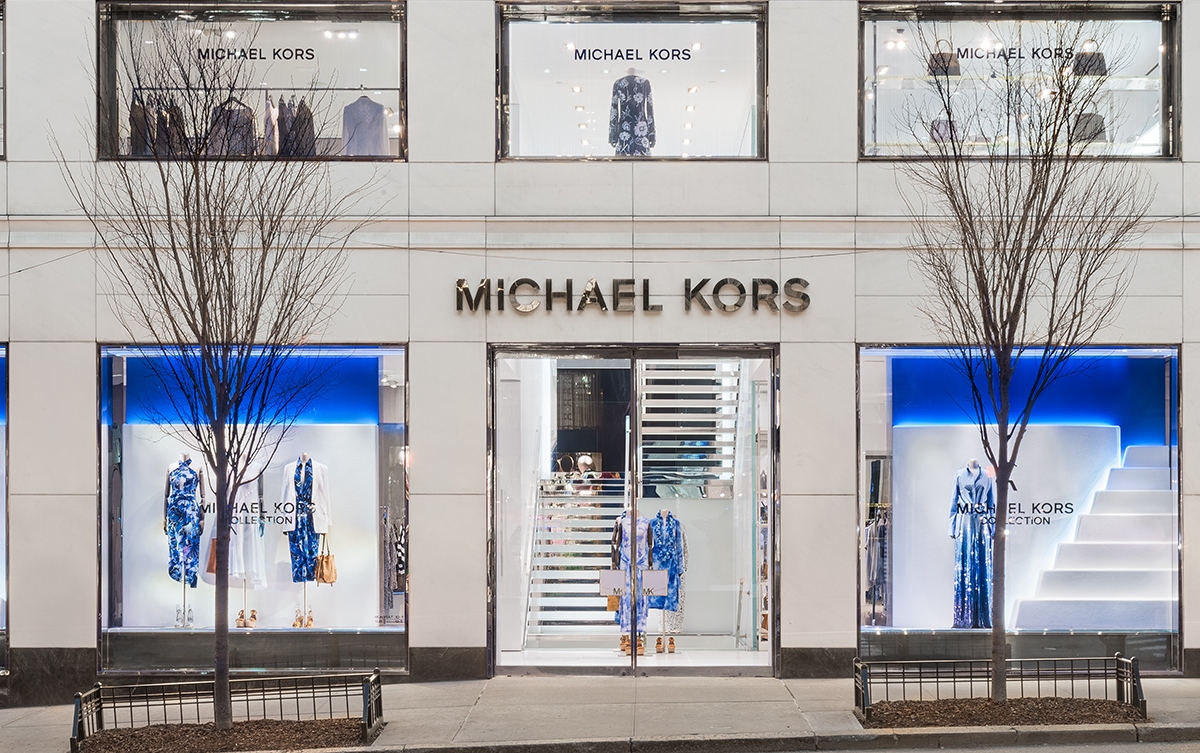In the world of fashion, there are few brands that have achieved the level of recognition and adoration as Michael Kors. Founded by American fashion designer Michael Kors in 1981, the brand has become synonymous with luxury, sophistication, and an unwavering commitment to timeless style. From its humble beginnings to its global prominence today, the Michael Kors brand has captivated fashion enthusiasts worldwide. This article delves into the fascinating journey of Michael Kors, highlighting its marketing strategies, marketing mix and STP of the brand.

Michael Kors, a native of Long Island, New York, possessed a passion for fashion from an early age. He honed his skills at the Fashion Institute of Technology in New York City, where he quickly distinguished himself as a prodigious talent. At the age of 19, Kors caught the attention of influential fashion industry insiders, and his career took off.
In 1981, Kors launched his eponymous brand, Michael Kors, with a collection of women’s clothing and accessories. The brand’s debut collection showcased Kors’ keen eye for blending classic American sportswear with a modern twist. This distinctive fusion of casual elegance and luxury laid the foundation for the brand’s success.
Michael Kors offers a wide range of products, including ready-to-wear clothing, handbags, footwear, accessories, and fragrance lines for both men and women. The brand is renowned for its exceptional craftsmanship, attention to detail, and use of high-quality materials. Each piece exudes an effortless sense of glamour, combining modern designs with timeless elegance.
The Michael Kors aesthetic embodies the concept of “jet-set luxury.” Inspired by Kors’ own jet-setting lifestyle, the brand’s creations exude a sense of cosmopolitan flair and sophistication. Whether it’s a sleek leather handbag, a tailored suit, or a statement watch, Michael Kors designs are characterized by clean lines, refined silhouettes, and a blend of classic and contemporary elements.
In the early 2000s, Michael Kors experienced a surge in popularity and expanded its reach beyond the United States. The brand’s global recognition skyrocketed when it ventured into the luxury accessories market, particularly with its covetable handbag collections. Michael Kors’ iconic “Hamilton” and “Selma” bags became coveted fashion staples, beloved by celebrities and fashion influencers alike.
In 2011, the brand made its debut on the New York Stock Exchange, solidifying its status as a major player in the fashion industry. This move propelled Michael Kors into a new era of growth and expansion, with flagship stores opening in prominent fashion capitals around the world, including New York, Paris, London, and Tokyo.
The Michael Kors brand’s enduring popularity can be attributed to its ability to stay relevant in an ever-changing fashion landscape. By infusing its designs with timeless elements while embracing contemporary trends, the brand appeals to a broad consumer base.
Moreover, Michael Kors’ success has been bolstered by strategic celebrity endorsements. Renowned personalities such as Michelle Obama, Blake Lively, and Kate Middleton have been spotted wearing Michael Kors designs, lending the brand an air of glamour and prestige. These celebrity associations have further cemented the brand’s position as a symbol of luxury and style.
Beyond its commitment to fashion excellence, Michael Kors also actively engages in social responsibility and philanthropic initiatives. The brand has supported numerous charitable causes, including efforts to combat hunger and promote education. In 2013, Michael Kors established the Watch Hunger Stop campaign, which raises funds and awareness for the United Nations World Food Programme.
Kors gained widespread recognition as a judge on the popular television show “Project Runway,” which he appeared on from 2004 until 2017. In addition to his work on TV, Kors has been awarded numerous accolades for his contributions to the fashion industry, including multiple CFDA awards and a spot in the Council of Fashion Designers of America (CFDA) Fashion Hall of Fame. Today, Michael Kors is one of the most recognized and respected names in fashion, known for creating stylish and versatile pieces that epitomize American chic.
Marketing Strategies of Michael Kors
Michael Kors has captivated the fashion industry with its iconic designs and timeless appeal. Behind its immense popularity lies a well-crafted brand marketing strategy that has propelled the company to great heights. In this part, we will delve into the key marketing strategies employed by Michael Kors, highlighting their effectiveness and contribution to the brand’s success.
Emphasis on Lifestyle – The brand’s marketing strategy revolves around showcasing a glamorous and aspirational lifestyle. Michael Kors not only sells products but also cultivates a distinct brand image associated with jet-set lifestyles, luxury travel, and modern elegance. Through carefully curated advertisements, social media presence, and celebrity endorsements, the brand creates an emotional connection with consumers, presenting itself as a symbol of sophistication and success.
Omnichannel Approach – Michael Kors understands the importance of meeting customers where they are. The brand has embraced an omnichannel marketing strategy, seamlessly integrating its online and offline channels. Whether it’s through its e-commerce website, mobile app, social media platforms, or brick-and-mortar stores, Michael Kors ensures consistent brand messaging, customer experience, and accessibility across all touchpoints.
Influencer Partnerships – One key component of Michael Kors’ marketing strategy is leveraging partnerships with influential individuals such as celebrities, bloggers, and social media personalities who can promote the brand to their large followings. For example, the company frequently works with models like Miranda Kerr and Gigi Hadid, both of whom have millions of followers across different social media platforms. By partnering with these individuals, Michael Kors gains additional visibility among consumers interested in fashion and luxury goods.
Celebrity Endorsements – Another way that Michael Kors uses marketing to increase brand awareness is by enlisting the support of well-known personalities such as actors, musicians, and athletes. These stars often wear Michael Kors clothes or carry its handbags during public appearances, providing valuable advertising for the brand without any direct financial compensation. Some notable celebrity supporters include Taylor Swift, Selena Gomez, and Rihanna.
Product Collaborations – To further appeal to target demographics, Michael Kors sometimes collaborates with other companies or brands to release limited edition merchandise. This not only generates buzz surrounding new product releases but also attracts new customers who may not have previously considered the brand due to a lack of alignment with their values or tastes. For instance, the company recently teamed up with the French luxury house Pomellato to create a line of fine jewelry combining elements of both labels.
Social Media Campaigns – Given the widespread use of digital technologies today, social media platforms play a critical role in many modern marketing plans. Michael Kors is no exception; it regularly publishes content to Facebook, Instagram, Twitter, and similar websites promoting its latest offerings, event news, or behind-the-scenes insights into creative processes. The brand also runs paid ads on various social media sites, utilizing targeting and retargeting those who visit the Michael Kors website but don’t purchase anything). Advertisements might feature specific items available for sale or highlight general characteristics associated with the Michael Kors brand, such as elegance, sophistication, and affordability. Paid search engine results, too, help ensure that people searching for terms related to luxury apparel or accessories will see relevant listings for Michael Kors products displayed near the top of page rankings. In this way, online marketing initiatives contribute to increased brand exposure, customer acquisition, and revenue growth over time.
Email Marketing Efforts – Email represents another important channel for keeping existing customers engaged and informed while encouraging referrals to friends and family members. Michael Kors likely maintains an email subscriber database consisting of past buyers, newsletter signups, and so forth, and sends out regular communications containing updates on seasonal trends, new arrivals, exclusive previews, or special deals accessible via unique codes or discount links. These messages can take the form of promotional emails, informational newsletters, curated editorials, birthday greetings, and other types tailored to individual recipients based on their preferences or browsing/shopping histories. While ensuring compliance with anti-spam laws like CAN-SPAM in countries where applicable, such marketing programs reinforce the connection between current customers and the Michael Kors brand over time.
Event Sponsorships and Fashion Shows – Participation in high-profile events and fashion shows is a crucial component of Michael Kors’ marketing strategy. The brand sponsors major fashion events, such as New York Fashion Week, and organizes its runway shows to generate buzz and media coverage. These events provide an opportunity for Michael Kors to showcase its latest designs, connect with industry insiders, and reinforce its position as a leading luxury fashion brand.
Michael Kors’ brand marketing strategies have played a pivotal role in establishing the brand as a global powerhouse in the fashion industry. By effectively positioning itself, creating aspirational narratives, embracing omnichannel approaches, leveraging influencers, implementing digital marketing, participating in events, nurturing customer relationships, and embracing sustainability, Michael Kors continues to captivate and engage its target audience while maintaining its luxury status. These strategies serve as valuable insights for aspiring fashion brands aiming to achieve similar success in the competitive marketplace.
Marketing Mix of Michael Kors
The marketing mix of Michael Kors refers to the combination of tactics used by the company to promote its brand and products. It is composed of four elements: product, price, place, and promotion. Here is how these elements come into play in the context of the Michael Kors brand:
Product
Michael Kors offers a diverse range of luxury fashion products that cater to various consumer needs. The brand’s product line includes handbags, accessories, footwear, apparel, and fragrances. Each product is meticulously designed to embody a timeless yet contemporary aesthetic. The attention to detail, quality craftsmanship, and use of premium materials ensure that Michael Kors products exude luxury and sophistication. By consistently delivering products that align with customer expectations, Michael Kors has built a strong reputation for excellence and established a loyal customer base.
Price
Michael Kors employs a premium pricing strategy to position itself as a luxury brand while maintaining accessibility. The prices of its products are higher than those of mass-market brands but lower than those of high-end luxury labels. This pricing strategy strikes a balance, appealing to consumers who aspire to own luxury fashion items without the steep price tags associated with exclusive designer brands. By offering attainable luxury, Michael Kors attracts a wider range of consumers, expanding its market reach.
Place
Michael Kors adopts a multichannel distribution strategy to ensure widespread accessibility. The brand operates its own retail stores in key locations globally, allowing customers to experience the brand’s ambiance firsthand. These stores serve as physical touchpoints that offer a consistent brand experience and showcase the full range of Michael Kors products. Additionally, the brand utilizes e-commerce platforms, such as its official website and other online retailers, to reach customers worldwide. Partnering with department stores and select third-party retailers further extends the brand’s distribution network, making its products available to a diverse customer base.
Promotion
Promotion plays a vital role in Michael Kors’ marketing mix, enabling the brand to create awareness, generate interest, and drive sales. The brand employs a comprehensive promotional strategy that encompasses various elements:
- Advertising: Michael Kors invests in high-impact advertising campaigns across multiple media channels, including print, digital, and television. These campaigns feature captivating visuals, influential personalities, and aspirational narratives that resonate with the brand’s target audience. Through these advertisements, Michael Kors reinforces its image as a luxury fashion brand and enhances brand awareness.
- Public Relations (PR): The brand actively engages in PR activities to garner media coverage and associate itself with influential personalities and events. Michael Kors collaborates with celebrities, influencers, and tastemakers who embody the brand’s values and aesthetics. These partnerships are leveraged to create buzz, generate excitement, and further elevate the brand’s visibility and credibility.
- Social Media Marketing: Michael Kors recognizes the power of social media in engaging with its audience. The brand maintains a strong presence on platforms like Instagram, Facebook, and Twitter, where it shares compelling visual content, behind-the-scenes glimpses, and highlights from fashion shows. By leveraging social media marketing, Michael Kors establishes a direct connection with its customers, encourages user-generated content, and drives engagement.
- Events and Sponsorships: Michael Kors actively participates in high-profile fashion events, most notably New York Fashion Week. The brand sponsors these events, organizes its own runway shows, and collaborates with renowned designers, models, and industry insiders. These events serve as platforms to showcase new collections, create buzz, attract media attention, and solidify the brand’s position in the fashion industry.
In conclusion, the marketing mix of Michael Kors combines product excellence, premium pricing, multichannel distribution, captivating promotions, knowledgeable staff, and visually appealing physical evidence. These elements work together to create a strong brand presence, capture the attention of consumers, and establish Michael Kors as a globally recognized luxury fashion brand.
Michael Kors’ STP Analysis: Targeting Fashionable Luxury Seekers
Successful marketing strategies rely on a thorough understanding of the target market. Michael Kors, a prominent luxury fashion brand, has effectively implemented the Segmentation, Targeting, and Positioning (STP) analysis to identify and cater to the needs and preferences of its core consumer base. In this part, we will delve into the STP analysis of Michael Kors, highlighting the brand’s segmentation approach, target market selection, and positioning strategies.
Segmentation
Segmentation involves dividing the market into distinct groups based on similar characteristics, needs, and behaviors. Michael Kors employs several segmentation variables to understand its diverse consumer base:
- Demographic: The brand targets both men and women, primarily focusing on the age group of 25-54 years. It caters to individuals who are fashion-conscious, seeking affordable luxury, and willing to invest in premium fashion items.
- Psychographic: Michael Kors appeals to individuals with a desire for luxury, sophistication, and modern elegance. The brand targets those who seek aspirational lifestyles and value high-quality fashion products.
- Behavioral: The brand segments its market based on consumer behavior, such as frequent purchases of luxury fashion items, interest in the latest fashion trends, and willingness to pay a premium for luxury goods.
Targeting
Once the market is segmented, Michael Kors identifies specific target segments that align with its brand positioning and objectives. The brand’s primary target audience includes:
- Fashionable Luxury Seekers: Michael Kors targets individuals who aspire to own luxury fashion items but prefer accessible luxury. These consumers appreciate designer aesthetics, quality craftsmanship, and the brand’s reputation but seek products at a more affordable price point compared to high-end luxury brands.
- Urban Professionals: The brand appeals to urban professionals who value style and sophistication. Michael Kors caters to individuals who desire fashionable attire for both formal and casual occasions, meeting the wardrobe needs of busy city dwellers.
- Millennial and Gen Z Shoppers: Michael Kors recognizes the growing influence of younger generations in the fashion industry. The brand targets tech-savvy millennials and Gen Z shoppers who value self-expression, seek trendy designs, and actively engage with social media and digital platforms.
By focusing on these target segments, Michael Kors can tailor its marketing strategies to effectively engage with its desired audience.
Positioning
Positioning is the process of creating a unique and compelling brand image in the minds of consumers. Michael Kors positions itself as a leading accessible luxury brand, combining high-end fashion with affordability. The brand’s positioning strategies include:
- Modern Luxury: Michael Kors presents a modern interpretation of luxury, incorporating contemporary designs and trends into its products. This positioning allows the brand to stay relevant and appeal to a younger, fashion-forward audience.
- Jet-Set Lifestyle: The brand cultivates an aspirational image associated with a jet-set lifestyle. Michael Kors’ marketing campaigns often feature luxurious travel destinations, elegant settings, and glamorous celebrities, creating an emotional connection and positioning the brand as a symbol of sophistication and success.
- Timeless Elegance: Michael Kors emphasizes timeless elegance in its designs, focusing on classic silhouettes, clean lines, and sophisticated details. This positioning strategy appeals to consumers seeking enduring style and investment pieces that transcend seasonal trends.
- Affordable Luxury: One of the key positioning pillars of Michael Kors is its accessibility. The brand offers luxury products at a more attainable price point than exclusive designer labels, providing consumers with an opportunity to indulge in high-quality fashion without breaking the bank.
Michael Kors’ STP analysis demonstrates its ability to identify and connect with its target market effectively. By segmenting the market based on demographic, psychographic, and behavioral factors, the brand has honed in on fashionable luxury seekers, urban professionals, and younger consumers. Through its positioning strategies of modern luxury, jet-set lifestyle, timeless elegance, and affordable luxury, Michael Kors has carved out a distinct and aspirational brand image. By aligning its marketing efforts with the STP analysis, Michael Kors continues to attract and retain its loyal consumer base in the highly competitive luxury fashion industry.
Also Read: Marketing Strategies, Marketing Mix and STP of Balenciaga
To read more content like this, subscribe to our newsletter



